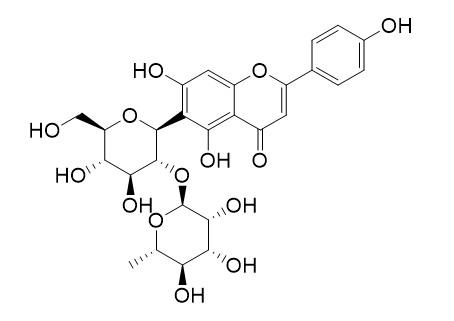Isovitexin-2''-O-rhamnoside (2''-O-alpha-L-Rhamnopyranosyl-isovitexin)
Isovitexin 2′′-O-rhamnoside, a phenolic, has antioxidant and antiproliferative activities.
Inquire / Order:
manager@chemfaces.com
Technical Inquiries:
service@chemfaces.com
Tel:
+86-27-84237783
Fax:
+86-27-84254680
Address:
1 Building, No. 83, CheCheng Rd., Wuhan Economic and Technological Development Zone, Wuhan, Hubei 430056, PRC
Providing storage is as stated on the product vial and the vial is kept tightly sealed, the product can be stored for up to
24 months(2-8C).
Wherever possible, you should prepare and use solutions on the same day. However, if you need to make up stock solutions in advance, we recommend that you store the solution as aliquots in tightly sealed vials at -20C. Generally, these will be useable for up to two weeks. Before use, and prior to opening the vial we recommend that you allow your product to equilibrate to room temperature for at least 1 hour.
Need more advice on solubility, usage and handling? Please email to: service@chemfaces.com
The packaging of the product may have turned upside down during transportation, resulting in the natural compounds adhering to the neck or cap of the vial. take the vial out of its packaging and gently shake to let the compounds fall to the bottom of the vial. for liquid products, centrifuge at 200-500 RPM to gather the liquid at the bottom of the vial. try to avoid loss or contamination during handling.
Molecules2022, 27(9):2613.
Biomed Pharmacother.2024, 176:116765.
Toxicol Rep.2021, 8:1131-1142.
Sci Rep.2021, 11(1):14180.
Foods.2024, 13(11):1739.
Revista Brasileira de Farmacognosia2024, 34:1276-1286.
Nutr Res Pract.2023, 17(4):670-681.
Appl. Sci.2021, 11(24),12080
BMC Complement Altern Med.2019, 19(1):339
Cell Signal.2022, 99:110433.
Related and Featured Products
J Agric Food Chem . 2013 Nov 6;61(44):10507-15.
Qualitative and quantitative analysis of phenolics in Tetrastigma hemsleyanum and their antioxidant and antiproliferative activities[Pubmed:
24151872]
The phenolic profiles of Tetrastigma hemsleyanum leaf extracts by different solvents (80% methanol, ethyl acetate and hexane) and their antioxidant and antiproliferative activities were investigated. Thirteen phenolic compounds (3-caffeoylquinic acid, 5-caffeoylquinic acid, 1-caffeoylquinic acid, 5-p-coumaroylquinic acid, isoorientin-2″-O-rhamnoside, isoorientin, orientin-2″-O-rhamnoside, orientin, 1-p-coumaroylquinic acid, vitexin-2″-O-rhamnoside, isovitexin-2″-O-rhamnoside, vitexin and isovitexin) were identified in T. hemsleyanum leaves for the first time, and six of them were quantified using a combination of LC-QTOF-MS and LC-QqQ-MS techniques. It was found that 80% methanol extract exhibited the highest antioxidant activities (DPPH, 3.32 mmol of Trolox/g DW; ABTS, 1.38 mmol of Trolox/g DW; FRAP, 1.85 mmol of FeSO4/g DW), while the hexane extract had the lowest (1.23, 0.43 and 0.13, respectively). Total phenolic contents (TPC) of various extracts of T. hemsleyanum leaves ranged from 28.95 to 275.71 mg of GAE/g DW. Also, total antioxidant activities as evaluated by ABTS, FRAP and DPPH assays were correlated well with TPC. In addition, 80% methanol extract provided antiproliferative activity on HepG2 cells (IC50 = 524 μg/mL). This paper provides a complete picture of phenolics in T. hemsleyanum leaves and relates them to their antioxidant and antiproliferative activities.
Planta Med . 1992 Dec;58(6):544-8.
Antihepatotoxic C-glycosylflavones from the leaves of Allophyllus edulis var. edulis and gracilis[Pubmed:
1484895]
From the leaves of Allophyllus edulis var. edulis and Allophyllus edulis var. gracilis nine C-glycosylflavones have been isolated and identified as schaftoside (8), vicenin-2 (9), lucenin-2 (10), isovitexin 2"-O-rhamnoside (11), cerarvensin 2"-O-rhamnoside (12), vitexin 2"-O-rhamnoside (13), isoorientin 2"-O-rhamnoside (15), orientin 2"-O-rhamnoside (16) and saponarin (17). In addition, gallic acid (2), the phenol C-glycosides bergenin (3) and 11-O-galloylbergenin (4), three flavonol 3-O-rhamnosides and a new C-glycosylflavone identified as mollupentin 2"-O-rhamnoside (14) were obtained from the leaves of Allophyllus edulis var. edulis. Their structures were elucidated on the basis of chemical and spectral data. For the first time the C-glycosylflavones were found to have remarkable anti-hepatotoxic activities against CCl4 and galactosamine cytotoxicity in primary cultured rat hepatocytes. Structure-activity relationships are discussed.
Molecules . 2013 May 10;18(5):5326-34.
Characterization of phenolic constituents from ephedra herb extract[Pubmed:
23666001]
Nine known compounds: trans-cinnamic acid, catechin, syringin, epicatechin, symplocoside, kaempferol 3-O-rhamnoside 7-O-glucoside, isovitexin 2-O-rhamnoside, herbacetin 7-O-glucoside, and pollenitin B and a new flavonoid glycoside, characterized as herbacetin 7-O-neohesperidoside (1) on the basis of spectroscopic analysis and chemical evidence, were isolated from a traditional crude drug, "Ephedra herb extract". Compound 1 had no effects on HGF-induced motility, whereas herbacetin, which is an aglycone of 1, significantly inhibited it.



